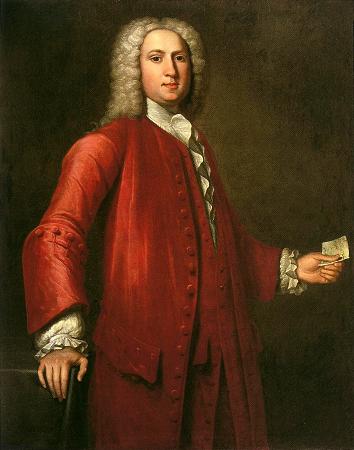
John Smibert. John Smibert was a Scottish American artist born in Edinburgh, Scotland, on 24 March 1688, and died in Boston, Massachusetts, British America on 2 April 1751.
Smibert began drawing while apprenticed as a painter and plasterer in Edinburgh. On moving to London in 1709 he worked as a coach painter and copyist.
1713-1716, he studied under Godfrey Kneller at the Great Queen Street Academy, then returned to Edinburgh, seeking work as portraitist. Smibert travelled to Italy from 1719 to 1722 to copy old masters and then settled in London where he worked as a portrait painter from 1722-1728.
Smibert became a member of the Rose and Crown Club and made a sketch for a group portrait of its members, including George Vertue, John Wootton, Thomas Gibson, Bernard Lens, and other artists. Among his London portraits is one of Bishop Berkeley who, in 1728, enticed Smibert to accompanied him to America, with the intention of becoming professor of fine arts in the college which Berkeley was planning to found in Bermuda.
The college, however, was never established, and Smibert settled in Boston, where he married in 1730. He lived at the corner of Brattle Street and Queen-Street. He belonged to the Scots Charitable Society of Boston. In 1728 he began painting Dean George Berkeley and His Family, also called The Bermuda group, now in the Yale University Art Gallery, Yale University, a group of eight
Smibert began drawing while apprenticed as a painter and plasterer in Edinburgh. On moving to London in 1709 he worked as a coach painter and copyist.
1713-1716, he studied under Godfrey Kneller at the Great Queen Street Academy, then returned to Edinburgh, seeking work as portraitist. Smibert travelled to Italy from 1719 to 1722 to copy old masters and then settled in London where he worked as a portrait painter from 1722-1728.
Smibert became a member of the Rose and Crown Club and made a sketch for a group portrait of its members, including George Vertue, John Wootton, Thomas Gibson, Bernard Lens, and other artists. Among his London portraits is one of Bishop Berkeley who, in 1728, enticed Smibert to accompanied him to America, with the intention of becoming professor of fine arts in the college which Berkeley was planning to found in Bermuda.
The college, however, was never established, and Smibert settled in Boston, where he married in 1730. He lived at the corner of Brattle Street and Queen-Street. He belonged to the Scots Charitable Society of Boston. In 1728 he began painting Dean George Berkeley and His Family, also called The Bermuda group, now in the Yale University Art Gallery, Yale University, a group of eight
Wikipedia ...